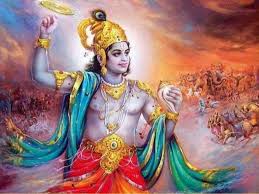It might seem surprising why Krishna would choose to come to this planet when He can accomplish anything from His divine abode. His appearance in this world is known as an avatār. Krishna incarnates here to connect us with Him through His mercy.
When dharma is in danger or under threat, Krishna manifests Himself. For instance, five thousand years ago, before Krishna’s appearance, Kaṁsa halted yajñas and worship of Krishna worldwide, claiming divinity himself and demanding worship. He persecuted devotees and annoyed Ṛṣi-munis and sādhus, aiming to destroy dharma. Bhagavān appears whenever dharma declines or the population of sādhus or Vaiṣṇavas diminishes to re-establish dharma. This is why Krishna made Yudhiṣṭhira Mahārāja the emperor, as he personified dharma.
Krishna comes every millennium by His independent will (Sambhavāmi). Unlike us, who are bound by karma to come into this world, Krishna decides when to appear. He assesses the situation and chooses the right time to descend. He comes for three main reasons:
- Paritrāṇāya Sādhūnāṁ: Bhagavān appears to deliver sādhus and ordinary people from the influence of māyā (illusion). By performing attractive līlās (divine pastimes), He helps devotees become satisfied discussing them(kathayantaś ca māṁ nityaṁ tuṣyanti ca ramanti ca, BG 10.9), bringing peace to their minds.This attraction leads to vairāgya (detachment), freeing them from māyā’s influence. Devotees are distressed not seeing Bhagavān, and to relieve them, He appears. Ṛṣi-munis and devotees like Śabarī, who waited thousands of years for Lord Rāma, find their distress alleviated by His appearance.
- Vināśāya Ca Duṣkṛtām: Simultaneously, Krishna annihilates asuras (demons). Although He could do this through His energies or devotees, Krishna enjoys fighting and personally comes to kill them, giving them mokṣa (liberation). He also destroys demonic qualities within us, like kāma (lust), krodha (anger), lobha (greed), and dveṣa (hatred). Bhagavān’s captivating form, qualities, and pastimes purify our hearts. Where Rāma resides, kāma has no place.
- Dharma-Saṁsthāpanārthāya: Here, dharma means bhakti (devotion). Bhagavān comes to establish bhakti, teaching us how to practice it through His devotees. He arrives with His associates to demonstrate true bhakti.
Establishing a Connection with Bhagavān
We should read the Bhagavad Gita (BG) and strive to connect with Bhagavān. However, Bhagavān Himself desires a relationship with us. Often, we run away by making various plans in different lives. If we sincerely wish to attain Bhagavān, our minds will naturally fix on Him, just as a businessman thinks about business even while on vacation. Time for bhakti is not found by carving out a schedule but by setting the right goal. When Bhagavān is our goal, we naturally find time for Him. Understanding why Bhagavān comes helps cultivate this desire. Viewing Bhagavān through the lens of BG enriches our connection with Him.
Conclusion
Krishna’s descent into this world, known as avatār, serves profound purposes beyond our comprehension. He comes to restore dharma, protect His devotees, and establish the principles of bhakti. Through His divine pastimes, He attracts our minds, freeing us from the bonds of material existence and instilling a deep sense of vairāgya (detachment).
Understanding Bhagavān’s motivations and actions helps us cultivate a genuine desire to connect with Him. By reading the Bhagavad Gita and Śrīmad Bhāgavatam, we can align our goals with His divine will. This alignment naturally directs our time and energy towards bhakti, allowing us to establish a meaningful relationship with Him.
In essence, Krishna’s presence in this world is an expression of His boundless mercy, guiding us towards spiritual fulfillment and eternal happiness. His teachings and pastimes illuminate the path of devotion, encouraging us to embrace bhakti wholeheartedly.
